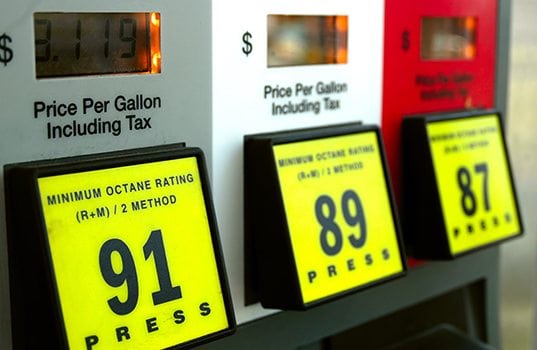From This Week in Petroleum, July 15, 2015
West Coast spot prices for conventional gasoline increased sharply last week, while falling slightly on the Gulf Coast and remaining flat on the East Coast. The Los Angeles, California, spot price for conventional gasoline increased nearly 90 cents per gallon (cents/gal) between July 6 and July 13, while San Francisco, California, and Portland, Oregon prices increased 24 cents/gal and 5 cents/gal, respectively (Figure 1). This most recent price rise results from a delay in receipts of waterborne imports of gasoline blending components and a decrease in total motor gasoline inventories within an already constrained supply chain.
West Coast spot gasoline prices typically trade at a premium to prices in other regions of the country because of the region’s unique product specifications and relative isolation from other domestic and international markets. As a result, West Coast gasoline markets are primarily supplied by in-region production, and prices react more quickly and strongly during times of local supply shortages. The West Coast gasoline spot price differential has been higher than usual for the past several months following a series of supply disruptions caused by an unplanned refinery outage in February and additional refinery outages in April. Also, West Coast gasoline demand is up 4% in the first four months of 2015 compared with the same time last year, putting additional pressure on the supply chain.
Higher spot market prices for gasoline on the West Coast have led to higher retail prices. As of July 13, the West Coast retail price for regular gasoline was 76 cents/gal above the national average, largely because of California’s 105 cents/gal premium compared with the national level (Figure 2). Similar to the gasoline spot market prices, the West Coast retail price premium compared with the national average has been elevated since the February 18 explosion and fire at ExxonMobil’s Torrance refinery in southern California. Each time the market has rebalanced in the wake of subsequent supply disruptions, prices have settled at levels that reflect the higher cost of bringing in alternative supply. However, despite the series of disruptions, retail prices are 41 cents/gal and 21 cents/gal lower than a year ago on the West Coast and in California, respectively, because of lower global crude oil prices.
In the five weeks following the Torrance outage, West Coast total motor gasoline inventories decreased by 3.0 million barrels. While gasoline inventories typically fall during that time of year, this year’s decrease was sharper than in the previous two years, and inventories dropped below the five-year range for four weeks in a row (Figure 3). In times of supply disruptions, inventories provide an immediate, although limited, source of alternative supply. However, because of product specifications and minimum operating inventory levels (tank bottoms), inventories alone are often insufficient to offset a prolonged market disruption. Movements from other regions within the country to the West Coast are limited because of minimal pipeline connectivity with neighboring regions and the fact that not all U.S. refineries can produce gasoline that meets California product specifications. Following the initial rapid decrease in West Coast inventories, storage levels recovered, and even exceeded 2013 and 2014 levels, as imports increased to replace in-region production. However, the reported 1.1 million barrel inventory drawdown for the week ending July 3 may have signaled that the market is experiencing renewed stress.
Because of its unique product specifications and long distance from international gasoline markets, the West Coast does not typically import much gasoline (Figure 4). From 2010 through 2014, total motor gasoline imports (including both finished motor gasoline and blending components) averaged 24,000 barrels per day (b/d) and were mostly from Canada, meeting approximately 1% of regional demand. However, in times of extended supply disruptions, alternative sources of supply come from farther away. These additional gasoline imports require long lead times and higher prices. Several weeks after the Torrance outage, West Coast gasoline imports more than tripled, and averaged 81,000 b/d from March 27 through June 26. Monthly data through April (the latest available) show California total gasoline imports coming from South Korea, Singapore, Japan, and Taiwan in Asia as well as Sweden, the United Kingdom, Italy, and the Netherlands in Europe. For the week ending July 3, West Coast gasoline imports dropped to zero and trade press reports indicate that cargos bound for California have been delayed. Buying may have also slowed in late June as the arbitrage window narrowed, meaning that fewer shipments are on the way to the West Coast. Longer supply chains are subject to such interruptions and when that happens, price reactions are often immediate and significant.
Other periods of price spikes have occurred in California, most notably in 2008, 2009, and 2012, that were similar in duration and magnitude to the current situation. By early June of this year, the other refineries were back in operation so only the Torrance refinery remains down. Prices will likely stabilize again when imports and inventories increase, but are likely to remain elevated until the repairs to the Torrance refinery are completed later this summer.













